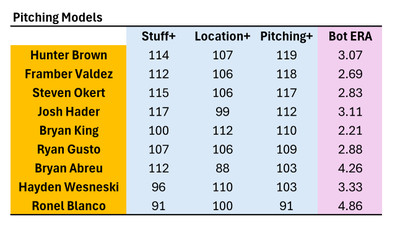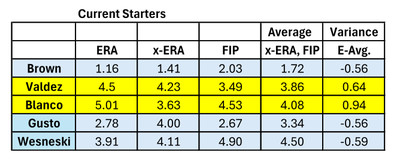
A forward looking view of the current Astros’ pitching
We know the Astros have pitched well so far through these first couple of months in 2025. The pitching staff ERA currently is ranked No. 4 in the MLB. But the key question is whether the Astros’ pitching staff can keep it up. So, I will focus more on the forward looking pitching metrics.
When I talk about forward looking stats, I’m referring to stats which tend to be more repeatable. The pitching results, in terms of actual runs allowed or ERA, generally are not predictive of the future performance—particularly at this early stage of the season. Pitcher BABIP can be quite volatile over small samples, and it has a strong influence on ERA.
Fielding independent Pitching (which is not dependent on BABIP) and SIERA are pitching metrics which have been shown to be somewhat more predictive of future performance. The Astros’ pitchers are ranked No 2 in FIP (3.38) behind only the NY Mets. The Astros’ pitching staff is ranked No. 2 in SIERA (3.36) behind only the Phillies. This indicates that the Astros’ strong pitching start is supported by peripherals; in short, it’s probably not a mirage.
We can also look at the pitching models which evaluate physical parameters like pitching stuff and command. The stuff measurements tend to stabilize in smaller samples than pitching stats like ERA. And the physical characterstics tend to drive pitching results and can suggest whether the results are sustainable.
The Pitching+ metric is part of the Stuff+ model, and is a composite of Stuff+ and Location+. The Astros’ pitching staff is No. 2 In Pitching+ (107), behind only the Phillies. The Pitching Bot model also measures stuff for indvidual pitches and derives an estimated BotERA associated with the pitcher’s stuff. The Astros are No. 2 in BotERA (3.48) behind only the Phillies.
The table below shows the Stuff+, Location+, Pitching+, and BotERA for each Astros’ pitcher with more than 10 IP. The “+” rankings are based on 100 as league average, and higher or lower numbers reflecting percentages above or below average.

Fangraphs
The Astros’ pitching results are very much supported by the stuff associated with their pitches. Hunter Brown’s impressive pitching is reflective of outstanding Stuff+, Location+ and Pitching+. Brown is No. 2 in Pitching+, behind only Tarik Skubal in the MLB. Framber Valdez is No. 4 in Pitching+ in the MLB. It’s noteworthy that Valdez’s Stuff+ and BotERA are much better than his currently lackluster ERA results.
Except for Ronel Blanco, all of the Astros starters and frequent relievers are above average in terms of Pitching+. Many of them have shown elite levels of stuff. Wesneski is slightly below average on the Stuff+ component but his outstanding Location+ metric allows him to post Pitching+ which is above average. Blanco’s ERA has regressed somewhat this season (5.01 ERA), and that is consistent with generally below average Stuff+ measures. His PitchBot ERA (4.86) is the highest among Astros’ pitchers.
The Statcast x-ERA can indicate whether the pitcher’s performance so far has been affected by batted ball “luck” in some form. The x-ERA shows the pitcher’s expected results, which may be more meaningful for predictive purposes than the actual ERA. From time to time, my articles compare actual ERA to the average of FIP and x-ERA to in order to evaluate the potential for future regression.
Overall the Astros staff’s ERA is slightly lower than both the FIP and x-ERA. Astros Team: ERA 3.26 x-ERA 3.71 FIP 3.30 Average of FIP and X-ERA: 3.50.
This could indicate potential for some regression toward a higher ERA in the future. But regression from 3.26 to 3.50 still leaves the Astros with solid results. In addition, the Astros have improved their defense so far, which could account for this variance between actual ERA and FIP/x-ERA. If the Astros team defense continues its improvement, the current results may turn out to be sustainable.
The table below shows the same kind of evaluation for each of the current starting pitchers. A negative variance indicates that the current ERA is lower than x-ERA and FIP, and vice versa for a positive variance.

Fangraphs Data
Brown, Gusto, and Wesneski (shown in blue) are the starting pitchers who may see some increase in their future, based on x-ERA and FIP. In the case of Brown, his ERA is so miniscule that regression is almost inevitable. But if Brown regresses from 1.16 to 1.72 ERA, he would still be one of the best pitchers in baseball. Both Gusto and Wesneski may be playing above their expected results, and could see some regression to the 4-ish ERA range. As mentioned above, improved team defense may partially explain the variance between FIP and ERA, which means that regression could be mitigated in the future.
Valdez and Blanco (shown in yellow) have posted ERAs higher than their x-ERA and FIP. Thus, the potential exists for regression in the direction of a lower ERA. The variance for these two pitchers suggests an ERA in the high 3’s for Valdez and around 4 for Blanco.
The Astros’ rotation has performed at a high level so far, and the exemplary performance is supported by pitching stuff and peripheral stats. That said, the overall ERA could regress somewhat, with Gusto and Wesneski posing the greatest risk of increasing their current ERA. Framber Valdez likely will improve his current ERA. There is no reason to believe he won’t end up close to his normal ERA in 2025. Blanco’s performance may be harder to predict, but it wouldn’t be surprising if he ends up in the same 4-ish ERA range as Gusto and Wesneski.
If all goes well, Lance McCullers Jr. may complete his rehabilitation pitching and join the Astros’ rotation in a week or so. It’s probably a little early to project how this will affect the rotation. Presumably McCullers would force one of the existing starters to join the bullpen, and push another reliever back to Sugar Land. Based on current ERA, one might choose Blanco to join the bullpen. However, the x-ERA would suggest that Blanco has pitched better than Wesneski and Gusto. That, in addition to Blanco’s seniority, probably means that Gusto or Wesneski would head to the bullpen.
Is it possible that McCullers, Jr. could be used as a tandem starter with either Wesneski or Gusto? That variant strikes me as a pretty good idea. McCullers probably will be limited in the number of pitches he can throw. And the combination approach potentially could give the bullpen a day off. But I’m getting ahead of myself here. Let’s see where things stand when McCullers completes his last rehab start.